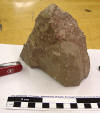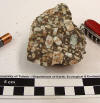Some Volcanic Rocks
Drop in to see these in person
 Volcanic
bomb (a small one). Although smaller than a softball, this raindrop-shaped
stone could fracture your skull if you were caught in a shower pyroclastic rain
near a volcanic vent. The dark color is due to mafic (magnesium-iron)
minerals - this bomb is probably andesitic, perhaps basaltic.
Volcanic
bomb (a small one). Although smaller than a softball, this raindrop-shaped
stone could fracture your skull if you were caught in a shower pyroclastic rain
near a volcanic vent. The dark color is due to mafic (magnesium-iron)
minerals - this bomb is probably andesitic, perhaps basaltic.
 Why
is this volcanic bomb red in color? This is from a very old (tens of
thousands of years old) cinder cone, and the magnetite has oxidized, turning
from magnetite (Fe3O4) to hematite (Fe2O3).
The original streamlined shape is still apparent. Volcanic bombs leave the
volcanic vent molten and solidify during their brief flight, developing this
streamlined shape from air friction.
Why
is this volcanic bomb red in color? This is from a very old (tens of
thousands of years old) cinder cone, and the magnetite has oxidized, turning
from magnetite (Fe3O4) to hematite (Fe2O3).
The original streamlined shape is still apparent. Volcanic bombs leave the
volcanic vent molten and solidify during their brief flight, developing this
streamlined shape from air friction.

Volcanic bomb just a little bit too big to collect, in a cinder (cone) quarry
near Clear Lake, California. The toddler was almost 1 year old.
 Large
cinder. Most cinders are filled with bubbles frozen into place as the
melted rock cooled in the atmosphere.
Large
cinder. Most cinders are filled with bubbles frozen into place as the
melted rock cooled in the atmosphere.

Part of a lava 'icicle' shows flow structure. Even flowing lava froze
so quickly many bubbles were trapped. Was this a bit of melted rock that
leaked from the molten center of a bomb that broke when it hit the surface?
Watch a video of a cinder cone eruption at night and look for flashes of red and
yellow from the dark, cold debris when a big pyroclastic hit the surface and
either breaks or breaks the cool shell of rocks it crushes.

Solidified volcanic ash is called tuff. No, tuff is not 'tough'
compared to most other rocks, in fact it makes and excellent building stone
because it is easily quarried, is stronger than adobe and relative low density.
This sample is rhyolitic. Some small quartz crystals can be seen when I look
at this rock under low magnification, using a geologist's tool called a hand
lens.
 The
Bishop Tuff, a thick deposit near the
Long
Valley caldera, which erupted about 760,000 years ago. The central
section of this tuff is welded (glass-like) because it was so hot.
The
Bishop Tuff, a thick deposit near the
Long
Valley caldera, which erupted about 760,000 years ago. The central
section of this tuff is welded (glass-like) because it was so hot.
 This
andesitic tuff contains hornblende, needle-shaped black amphibole
minerals.
This
andesitic tuff contains hornblende, needle-shaped black amphibole
minerals.

Basalt is dense and black. Andesite is often as black as basalt
so sometimes it takes a thin section (thin polished wafer of rock) and
microscope to discriminate between basalt and andesite. This specimen has
green olivine crystals, a diagnostic characteristic of basalt.

A different perspective of this basalt sample.
 Obsidian
can be black but this volcanic glass may well be rhyolitic (rich in silica).
Lava cooled so quickly that true mineral crystals did not get a chance to form
from the entire melt. The circular concoidal fracture is a diagnostic
characteristic of glass.
Obsidian
can be black but this volcanic glass may well be rhyolitic (rich in silica).
Lava cooled so quickly that true mineral crystals did not get a chance to form
from the entire melt. The circular concoidal fracture is a diagnostic
characteristic of glass.

Volcanic breccia. Solid rock was shattered and the pieces (light
gray) cemented together by hot ash (pinkish material).
Pinnacles National Monument
contains mega-breccia: volcanic breccia with clasts (shattered fragments) as big
as a house, these clasts themselves composed of breccia.
 Porphyry
is a volcanic rock characterized by a bi-modal crystal size. Apparently
crystals were leisurely forming in an underground magma chamber when an eruption
occurred, cooling the mix of molten rock and crystals so quickly that the molten
part crystallized without having time to organize into big crystals.
Porphyry
is a volcanic rock characterized by a bi-modal crystal size. Apparently
crystals were leisurely forming in an underground magma chamber when an eruption
occurred, cooling the mix of molten rock and crystals so quickly that the molten
part crystallized without having time to organize into big crystals.
 Pumice
- volcanic glass foam, the rock that floats. Bubble-filled melted rock foam
cooled and formed a solid bubble-filled stone. This sample was collected
from the Gulf of Fonseca in 1971. It floats. Pumice is fragile,
often crushed if buried by ash and broken down by abrasion if washed up and down
a beach. Before the invention of the inexpensive disposable razor, female
students at the teachers' college were I was working used pumice to shave their
legs. Pumice is crushed for abrasive in soap (Lava
Soap) and small pieces are used for cosmetic purposes (exfoliation, reducing
calluses). Some pumice is too dense to float.
Pumice
- volcanic glass foam, the rock that floats. Bubble-filled melted rock foam
cooled and formed a solid bubble-filled stone. This sample was collected
from the Gulf of Fonseca in 1971. It floats. Pumice is fragile,
often crushed if buried by ash and broken down by abrasion if washed up and down
a beach. Before the invention of the inexpensive disposable razor, female
students at the teachers' college were I was working used pumice to shave their
legs. Pumice is crushed for abrasive in soap (Lava
Soap) and small pieces are used for cosmetic purposes (exfoliation, reducing
calluses). Some pumice is too dense to float.
 Pumice
floating in a pan of water. Check out the video.
Pumice
floating in a pan of water. Check out the video.
Return to Index

 Volcanic
bomb (a small one). Although smaller than a softball, this raindrop-shaped
stone could fracture your skull if you were caught in a shower pyroclastic rain
near a volcanic vent. The dark color is due to mafic (magnesium-iron)
minerals - this bomb is probably andesitic, perhaps basaltic.
Volcanic
bomb (a small one). Although smaller than a softball, this raindrop-shaped
stone could fracture your skull if you were caught in a shower pyroclastic rain
near a volcanic vent. The dark color is due to mafic (magnesium-iron)
minerals - this bomb is probably andesitic, perhaps basaltic.












